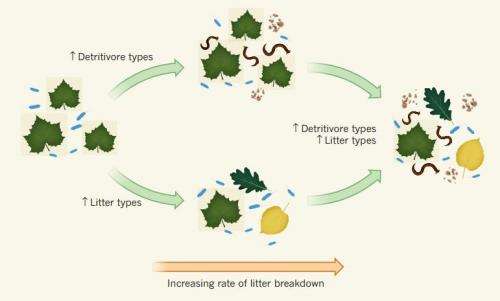May 8, 2014 report
Field study suggests decreased diversity reduces liter decomposition rates

(Phys.org) —A large team of researchers with members from many European countries and one from Canada has found evidence that suggests that reducing the diversity of the microorganisms that decompose plant matter or the types of plants they feed on, reduces decomposition rates. In their paper published in the journal Nature, the research team describes their field studies and what their results might mean in a world where biodiversity loss has become the norm.
Life on Earth is complex, obviously, filled with more interactions and reactions than we humans will likely every fully comprehend, yet, there are some parts of the whole we do grasp. Most of the air we breathe, for example comes from work done by plants. We also know that when plants die, detritivores (microorganisms and invertabrates that break down plant material, aka, litter) tear the litter apart into its baser parts, some of which wind up in the soil, and some of which wind up in the atmosphere. Both are important because both nitrogen and carbon dioxide are involved. But, one part of the process has not been well understood; how does the degree of diversity of plants, or detritivores relate to the speed or efficiency of decomposition? That's what this latest research team set out to learn.
To find out, they team set up experiments in five different aquatic and terrestrial areas, which ranged from the tropics to the subarctic. Each experiment consisted of restricting plants or detritivores or both in a controlled environment and measuring the rate at which decomposition occurred in each. They found that decomposition slowed when either detritivores or plants were less diverse, and even more so when both were less diverse. These findings suggest that we can expect decomposition to take longer in as we general as we move forward in time because we are currently experiencing biodiversity loss in both detritivores and plants—which in turn is very likely to impact the world's global carbon budget going forward.
But that wasn't all, the team also found a link between the mechanism that drives liter diversity and movement of nitrogen between litter types. High quality carbon appeared to be a factor in causing the movement of detritivores (that carry nitrogen with them) between litter types. Thus, the amount of carbon in the soil or in the air appears to also play a role in decomposition rates—if true, such information could be used by scientists to better understand the carbon life cycle as a whole.
More information: Consequences of biodiversity loss for litter decomposition across biomes, Nature 509, 218–221 (08 May 2014) DOI: 10.1038/nature13247
Abstract
The decomposition of dead organic matter is a major determinant of carbon and nutrient cycling in ecosystems, and of carbon fluxes between the biosphere and the atmosphere. Decomposition is driven by a vast diversity of organisms that are structured in complex food webs. Identifying the mechanisms underlying the effects of biodiversity on decomposition is critical given the rapid loss of species worldwide and the effects of this loss on human well-being. Yet despite comprehensive syntheses of studies on how biodiversity affects litter decomposition, key questions remain, including when, where and how biodiversity has a role and whether general patterns and mechanisms occur across ecosystems and different functional types of organism. Here, in field experiments across five terrestrial and aquatic locations, ranging from the subarctic to the tropics, we show that reducing the functional diversity of decomposer organisms and plant litter types slowed the cycling of litter carbon and nitrogen. Moreover, we found evidence of nitrogen transfer from the litter of nitrogen-fixing plants to that of rapidly decomposing plants, but not between other plant functional types, highlighting that specific interactions in litter mixtures control carbon and nitrogen cycling during decomposition. The emergence of this general mechanism and the coherence of patterns across contrasting terrestrial and aquatic ecosystems suggest that biodiversity loss has consistent consequences for litter decomposition and the cycling of major elements on broad spatial scales.
Journal information: Nature
© 2014 Phys.org


















